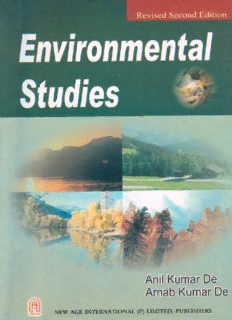
Environmental Studies PDF
Preview Environmental Studies
This page intentionally left blank Copyright © 2005, 2001 New Age International (P) Ltd., Publishers Published by New Age International (P) Ltd., Publishers All rights reserved. No part of this ebook may be reproduced in any form, by photostat, microfilm, xerography, or any other means, or incorporated into any information retrieval system, electronic or mechanical, without the written permission of the publisher. All inquiries should be emailed to [email protected] ISBN (13) : 978-81-224-2636-6 PUBLISHING FOR ONE WORLD NEW AGE INTERNATIONAL (P) LIMITED, PUBLISHERS 4835/24, Ansari Road, Daryaganj, New Delhi - 110002 Visit us at www.newagepublishers.com Preface v Preface The warm response to the First Edition of this book encouraged the authors to bring out the Second Edition in a thoroughly revised and updated form. The Hon’ble Supreme Court of India ordered in 1991 introduction of a common course on Environment in colleges and universities at under-graduate levels but the order was not properly implemented. Displeased with non-compliance of the order, the Supreme Court again ordered in 2003 for introduction of Environment as a compulsory subject at higher secondary level in schools and under-graduate levels in colleges from 2004–2005 session and issued warning of legal action, if necessary. The prevailing confusion in academic communities is due to lack of suitable textbooks (Green Syllabus) and also orientation about the subject among the teachers and students of various disciplines. The authors, with their long experience in environmental teaching and research, came forward to fulfil the need of the hour by meeting the challenge for the common course—the First Edition was published in 2001 and now the Second Edition is released in 2005. The Glossary or Key Terms and Concepts is given at the end of each Chapter for the benefit of the students. Feedback Exercise (Chapter 11) followed by University Questions will vi Preface be useful for the students to test their knowledge in the subject. Chapter 8 on Environment and Public Health has been streamlined by omitting some sections. Notable additions in various sections are: Natural and Man-made Changes in Environment and Disasters (Section 1.3); Origin of the Earth— Continents and Ocean Basins, Origin of the Atmosphere (Section 2.1); Geologic Cycle (Section 2.5); Biomes— Ecosystems (Sections 3.1.1, 3.1.2) Odour Pollution (Section 6.8). The authors cordially invite constructive suggestions and comments for further improvement of the book from fellow teachers and beloved students. It is a pleasure to place on record grateful thanks to Mr. S. Gupta, Managing Director, New Age International Publishers, New Delhi for encouragement and prompt publication. Our sincerest thanks are due to Mrs Kalpana De, Chandrima and Charchita for their constant encouragement. Simanta Palli Santiniketan–731235, West Bengal ANIL KUMAR DE January, 2005 ARNAB KUMAR DE Contents vii Contents Preface v 1. Introduction 1 1.1 Basic Concepts 1 1.1.1 Environmental Studies 2 1.2 Land Use Patterns—Agriculture, 3 Housing and Urbanisation 1.3 Natural (Non-Anthropogenic) and 4 Man-Made (Anthropogenic) Changes in Environment and Disasters 1.3.1 Natural Changes in Environment 4 1.3.2 Natural Disasters 5 1.3.3 Man-Made (Anthropogenic) Changes 7 in Environment and Disasters 1.3.4 London Smog 8 1.3.5 Mediterranean—A Dead Sea 8 1.3.6 Nuclear Explosions 8 1.3.7 Minamata Disease 9 1.3.8 Bhopal Disaster (December 3, 1984) 9 1.3.9 Chernobyl Disaster (1986) 9 1.3.10 Gulf War Hazards 10 viii Contents 1.4 Development vis-a-vis Environment 11 1.5 Environmental Hazards—Human Concern 12 about Environment Key Terms and Concepts (Glossary) 13 Questions 15 2. Nature and Natural Processes 16 2.1 Planet Earth—Origin and Evolution 16 2.1.1 The Sun in the Solar System 16 2.1.2 Origin of the Earth—Continents 17 and Ocean Basins 2.1.3 Origin of the Atmosphere 18 2.2 Components of the Earth/Environmental 19 Segments 2.2.1 Lithosphere 19 2.2.2 Hydrosphere 21 2.2.3 Atmosphere 21 2.2.4 Biosphere 22 2.3 The Climate of the Earth 22 2.3.1 Rain, Storms and Lightning 23 2.4 Origin and Evolution of Life 25 2.5 Natural/Biogeochemical Cycle 26 2.5.1 The Geologic Cycle 26 2.5.2 The Hydrological Cycle 26 2.5.3 The Oxygen Cycle 28 2.5.4 The Nitrogen Cycle 29 2.5.5 The Carbon Cycle 30 2.5.6 The Phosphate Cycle 31 2.5.7 The Sulphur Cycle 33 Key Terms and Concepts (Glossary) 34 Questions 36 3. Ecosystems 37 3.1 Ecology and Ecosystem 37 Contents ix 3.1.1 Biomes 39 3.1.2 Ecosystems 40 3.2 Forest Ecology 42 3.2.1 Forest Conservation 43 3.2.2 Biodiversity 45 3.2.3 Sustainable Ecosystem 46 Key Terms and Concepts (Glossary) 47 Questions 48 4. Population and Environment 49 4.1 Human Population and Distribution 49 4.1.1 Distribution 50 4.1.2 Population Density 51 4.1.3 Age Structure 51 4.1.4 Doubling Time 52 4.1.5 Fertility Rate 52 4.1.6 Infant Mortality/Life Expectancy 53 4.1.7 Carrying Capacity 53 4.2 Population Stabilisation/Sustainable 54 Development (Indian context) 4.2.1 Kerala Model 55 4.3 Women and Environment 56 4.3.1 Woman Power 57 4.4 Human Development 57 Key Terms and Concepts (Glossary) 59 Questions 60 5. Land and Water Resources of the Earth 62 5.1 Land, Water and Air—Interrelationship 62 in Ecosystem 5.2 Land Resource and Land Uses 62 5.2.1 Land Use Planning 63 5.2.2 Watershed Management 64 5.2.3 Grazing Land 65 5.2.4 Wastelands 66
Description: